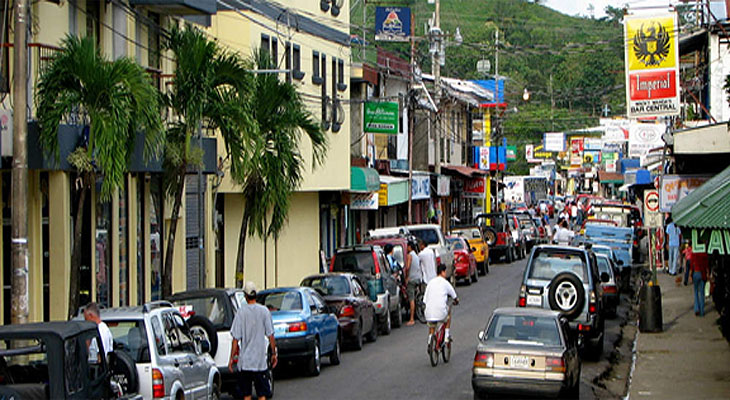|
|---|
Main Street Quepos - All Things Are Relative to Wacky Wanda's ("Bar Central" - Right) |
Broken News
(All the News That's Fit to Reprint)
Brits Discover Hemholtz
 |
 |
Whistler Project Manager Mrs. Hemholtz |
It had to be the British that figured this one out.
Not intent to just sit back and enjoy tea with crumpets or perhaps cucumber sandwiches, one of her majesty's subjects had to ask; how and why do tea kettles whistle?
So as not to be seen as whistling in the dark, the study was conducted by a team from the Engineering Department at the University of Cambridge, England. The results were published in the monthly scientific journal of the American Institute of Physics called Physics of Fluids (did I ever tell you how much I hated Physics and, in particular, Fluid Dynamics, in engineering school? - there, I blew the whistle on myself).
The results of their studies show they weren't just whistling dixie. A series of experiments pointed to the cause of the whistle being a principle in physics called a "Hemholtz Resonator", a mechanism that describes sound produced from a swirling vortex of a fluid forced through a narrow opening. It's the same phenomenon that causes a bottle to hum when air is blown across the top. (yeah, sure, I knew all along that the tea kettle and humming Coke bottle were Hemholtz Resonators)
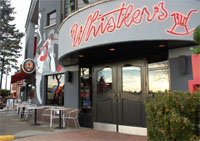 |
Line 'em Up Mate! |
The model created may have important applications in other areas such as explaining how dangerous vibrations occur in piping and plumbing. Knowing how the vibration is formed may help in designing systems that reduce it drastically or eliminate it entirely. These British engineers are slick as a whistle, don't you think?
My guess is that after they concluded their findings and wrote the report, the engineering boys at Cambridge went down to Whistler's Tavern to have a few pints, to wet their whistle and ruminate on their findings.
Sorry amigos, I just can't resist this stuff.
¡Pura Vida!
Traveling Tuna
Scientists tag all sorts of animals, even fish, in order to learn their migration patterns in an effort to promote conservation. So it was not unusual for Venezuelan fishermen to catch an albacore tuna in their nets off their country's coast recently and find a tag attached to it.
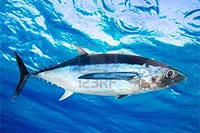 |
Have a Nice Trip, Charlie? |
When the tag was researched, however, it was learned that this particular fish had first received its tag over six years ago off the Basque coast of Spain near the French border (Bordeaux). That's a distance of some 6,370 kilometers (just under 4,000 miles), the longest distance ever reported for a fish to travel. Now that was 6,370 kilometers as the crow flies, but probably a heck of a lot longer as the fish swaggers across the Atlantic.
Our friend Charlie the tuna matured during his voyage. When he was tagged, he measured 50 centimeters (20 inches) and weighed 2.5 kilos (5.5 pounds) and when he arrived in Venezuela he had grown to 100 centimeters (40 inches) and 21.8 kilos (48 pounds - nice catch if you're an angler).
GG has had trips from Europe where I've grown in similar fashion, but mostly in girth.
What's not clear from the press report is whether or not Charlie ended up as sushi or in a can. Perhaps they retagged him for the return trip. If he wants to get back to Basque country, he might like to follow Christopher Columbus' route by wandering up to the northern Caribbean and catching the Gulf Stream; it worked for Chris four times.
Banana Birds
If you had Thanksgiving this year in Costa Rica like GG and many of his friends did, you know that good Turkey is sometimes difficult to find and is quite expensive.
 |
| Banana-Loving Turkeys |
The primary eating bird here by far is the chicken, which I sometimes think should be designated the national bird because it's so prevalent. Ticos love pollo con anything but it seems that they're just getting around to sampling turkey and liking it. If it weren't for displaced gringo ex-pats like yours truly we probably wouldn't see "pavo" in the markets at all. As it is, the only time it's common is during Thanksgiving time up to Christmas and New Years..
Now we have a retired ex-pat here who has taken it upon himself to study the noble turkey and raise a small heard here. His name is Garry Wiersum and he has an organic farm near Tarbarcia not far from Puriscal. He's raising a Naragansett specie of turkey, like the wild ones that are prevalent along the northeast coast of the U.S. and were probably more like the ones served by the Puritans at the first Thanksgiving dinner. The common domesticated variety in the U.S., it seems, has slowly become diluted of real turkey flavor after eons of farm breeding.
Señor Wiersum has learned one other very interesting thing about his turkeys; they like bananas, of which he has plenty growing on the farm. It's been GG's contention for some time that Tico cuisine doesn't take enough advantage of the wonderful tropical fruits here.
Maybe now that's changing at the feeding stage.
Rumble Talk
(Shaky Happenings On or About the Pacific Rim)
This year there was a several month period of significant quiet here as related to earthquakes, but the last couple of months has seen more frequent "stronger" tremors, in the 4.5 to 5.5 Richter range.
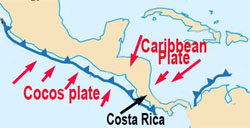 |
Illustration of Cocos Plate Movement |
That level of shaking, of course, is no comparison to something like the horrendous 7.6 terremoto of September 5, 2012 in which GG was intimately involved. A 7.5 R tremor is roughly 100 times the energy release of a 5.5 earthquake.
Scientists from all parts of the world are continuously studying how earthquakes happen in an effort to find a way to predict them. Now a new study from the Monash University School of Geosciences (Australia). A certain Professor Schellart of said university believes he can identify areas that are likely to be more prone to massive earthquakes.
The interaction of the Cocos Plate with the Caribbean Plate that occurs along the Central American isthmus (see diagram) is one of the areas Professor Schellart says is one subduction zone (one plate diving below another, the friction between them causing ruptures and resulting in earthquakes) that is likely to produce, eventually, a huge quake.
In another report, researchers at Georgia Tech say they predicted the aforementioned big one in the Nicoya peninsula in September, 2012. Something about having a new ability to "map" a subduction zone and determine where the plates "lock up". They had mapped the Nicoya and found such a lock up and reported it as a danger zone.
It would have been nice if, after knowing where the big one would come, they knew when. I could have used an hour's warning that day when I was standing on the first floor of the 10-story Puntarenas Hospital as the whole building turned to jelly and the facade kept peeling off the outside walls.
| Check Out Recent Earthquakes Around the World Posted by the U.S. Geodetic Survey: Today's Quakes |
|---|
Costa Rican Health Care
(A Primer - Part II, The Public System)
Last month in Part I, we looked at the private health care system in Costa Rica. This month we review the public system.
N.B. Be aware that rules regarding using public health care services here, as well as their availability, change often, so check the latest happenings with as many sources as possible, including reliable internet blogs and people, like myself, who are living the system every day. Readers are encouraged to correct, embellish or otherwise add to what is being written here and I will publish their remarks (at least the pertinent and pithy ones) in future editions. To comment, reach me here: GG's Email.
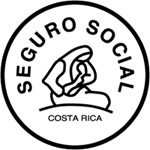 |
CCSS Logo |
The Costa Rican public health system, affectionately known as the "Caja" (Cah-hah). is administered under the social security administration or Caja Costarricense de Seguro Social (CCSS). CCSS is the organization that runs public hospitals and clinics and also administers the national pension system.
In order to participate in the public health system in Costa Rica, except on an emergency room basis, you must have a cédula or residency document. Also, in order to get a cédula you must join the Caja. Obtaining the two documents happens simultaneously these days. At the tail end of the cédula process you are required to join the Caja before you receive your cédula card.
There are approximately 20 public hospitals and as many as 800 public clinics in Costa Rica administered by the Caja. The country, for administrative purposes is divided into seven provinces, about 80 cantons and several hundred districts within the cantons. There is at least one clinic in every district but many have more than one. A district may also have a hospital; Quepos (Province of Puntarenas, Canton of Aguirre) enjoys a sizeable hospital but there are also a number of clinics north (Jacó), south (Dominicál) and east (Londres) of the town. The clinics are designed to fill in the gaps in service and distance between hospitals and offer basic care to local residents but not major treatment or long term care. For that you need to go to the hospitals.
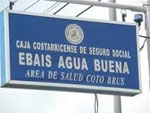 |
An Ebais Clinic |
The clinics are administered by a division of the Caja known as EBAIS (Ay-bye-ees: Equipos Básicos de Atención Integral en Salud (Basic Teams of Global Health Care). The Ebais contracts with private health care firms to staff the clinics. Ebais is also the department that issues the Caja card, or carnet. (some of the more erudite among us pronounce this in the French manner as car-nay, but many Ticos also say car-net,). The carnet shows that you're in the Caja and verifies, along with your most recent payment receipt for health services for the current period, called your "comprobante", that you are eligible for treatment. Failing that approval, I presume, gets you treated at the emergency room level only.
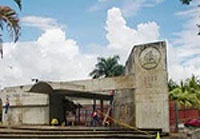 |
Main Entrance Quepos Hospital |
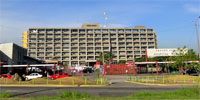 |
| Hospital Mexico - San Jose |
The public hospitals also vary in size and capabilities. Hospital Mexico in San José is the mother of the public hospitals. They have a slew of specialists (for example, they have 6 Ophthalmologists alone) and the most advanced technology available in the system.
Quepos is a relatively small hospital.but has good emergency room care and a number of general practitioners (internists, pediatricians, a psychologist) for preventive care check-ups. It also provides a pharmacy where all the medicines that can be prescribed within the Caja are available. With a prescription, a carnet and a comprobante, you can get all the medicine prescribed by a Caja physician at no added cost over your standard monthly payment.
Coming from a North American experience, Quepos Hospital took a little getting used to. There is no air conditioning in the building only in the doctor's offices, the administrative offices and the examination/treatment rooms and this is typical also in the largest hospitals like Hospital Mexico. The public areas and even the patient rooms are not air conditioned and are open to the atmosphere although the patient rooms are screened and equipped with fans. There are staff continuously sweeping and mopping the floors in the public areas with what I assume is a disinfectant although my poor nose can't detect it.
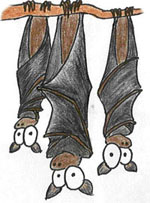 |
"Wazzup, Doc?" |
This reminds me of a phenomenon I've never seen in a hospital before. The waiting area near the pharmacy and laboratory has a cathedral ceiling and I noticed on one of my early visits that there were bats (that's right, the flying kind) hanging from the ceiling, sleeping of course since it was daytime. I guess they must fly out at night to plunder local fruit trees and devour insects like good bats do. So, if you see a patient wandering the hospital mumbling that he's got "bats in the belfry" he may not be talking about his personal psychological condition.
The bat count on my last visit was six, down considerably from earlier visits.
Speaking of things batty, let's get the bureaucracy thing out of the way. This is socialized medicine amigos and as such is typically and, apparently, hopelessly slow and bureaucratic. Waiting lines are long, both for getting today's service and for getting a major procedure scheduled. When you get an "appointment" for 9 AM, you should look at that as simply a good time to check in with the doctor's assistant (getting there earlier is even better as patients are processed in the order of arrival, not according to a theoretical appointment time).
 |
Welcome to the CaJa! |
It's common to wait 1-1/2 to 2 hours before seeing the physician and I've actually waited up to three. For an old retired dude this is a mere inconvenience but I do feel empathy for the typical Tico working slug who has little time off the job and must use it waiting in lines for service.
The typical waiting lines for the pharmacy are 1 to 1-1/2 hours. I usually deliver my prescriptions and go to breakfast while they're being filled. It's prudent to plan for spending at least a half day at the hospital if you need to see a doctor as well as get prescriptions filled on the same day. Bring a book to read in the non-air conditioned waiting area.
I was first diagnosed with a cataract problem in early November 2012 at Puntarenas Hospital (I was required to get a referral from my Quepos doctor as the Quepos Caja does not have an Ophthalmologist). After seeing the doctor in Puntarenas on the second visit there and being diagnosed, he told me to ask the desk on the way out for a check-up appointment in six months. The desk told me (in November 2012) they couldn't schedule anything for 2013 as the computer wouldn't allow it so "come back next month" to set the appointment (no appointment can be arranged by phone or email, only in person). The fact that I lived three hours by bus from Puntarenas did not alter the system requirement.
 |
I came back early in January to be sure the computer was operating in the current year. After waiting an hour or more the desk assistant gave me an appointment for October (2013), stretching the six-month follow up to a year. The interesting thing is Puntarenas may have an Ophthalmologist but they're not equipped to do cataract surgery so the object of the second Puntarenas doctor visit was to get a further referral to Hospital Mexico in San José where they have the equipment to do the procedure. There would still have to be a number of hurdles to clear there.
By June my vision had deteriorated significantly so I enlisted a Tico friend to help me get the appointment moved up. After considerable haggling and two more visits on different days, and also writing a "denuncio" (complaint letter) to Puntarenas hospital management that was suggested by their own office, I finally got a referral to Hospital Mexico for an examination. Then I had to go through the same procedure again in San José, first showing up personally to get an appointment, then open a new file with that hospital (another waiting line) and then achieving the appointment. Finally I got a date for surgery and the first eye was done on October 6, 2013, nearly one year after receiving the diagnosis. Since then I have received an appointment for surgery on the second eye for January 20, 2014, which is an earlier date than the March 25th they first suggested. Pleading and cajoling seem to help this time.
 |
Diagnosis: Methinks Señor Doctor Could Use Some Rogaine |
Now let's talk about the good aspects of the system, of which there are two in my opinion. The first is cost. My monthly payment for all services and procedures (within the constraints of Caja-limited procedures and bureaucracy) and all medicines (sometimes limited to generics) is currently 34,800 colones (about $70). It gets adjusted upward every January. That cost is compared to about $40 per doctor's visit in the private system and $150-200 that I was paying each month for the medicines that resulted from my congestive heart failure episode.
My guess is that this kind of inexpensive health care will not last forever. The system has already been forecasted to go into the negative in 2015 according to recent press reports. It might help if the government would cough up the $2 billion it deducted from government employee salaries for the Caja but never transferred to that department, preferring, like good politicians, to spend it on other things. The total national budget here is only $14 billion per year so that this hold-back would be equivalent to the U.S. government holding back about $450 billion. But, of course, the Costa Rican government doesn't have the $2 billion because the government, despite having a balanced budget amendment, is running at a 40% deficit these days (how'd they manage to do that?). The chance that national finances and the health care system will face a true financial crisis in the next 5-10 years is as high here as it is in the United States.
But the second positive is, in my mind, even more important than the cost savings. I am happy to report that the patient care from nurses, doctors, technicians and the like, once you get past the bureaucratic wall, is competent, sensitive and caring. I have dealt with two doctors in Quepos, one in Puntarenas, one in San José and a number of staff and technicians in all three locations. With the exception of a couple of grouchy and overworked office staff droids in Puntarenas, all these people have been effective and caring, making the hassles with the bureaucracy worthwhile.
I admire the doctors in this system who work, like my local doctor, on the order of 70 hours per week between staffing the Caja in the mornings and afternoon and opening their private practice for several hours in the evening. This is a tough lifestyle and I hope they can fit in some vacation here and there to relieve the stress.
Buen trabajo, buena suerte y buen salud, amigos!
Legend of La Segua
(Don't Share Your Horse With a Strange Woman)
Costa Rica has many legends, some based in fact and others just whimsical. Many are romantic; still others are meant to teach a lesson. This one is a tale of pay-back for infidelity and is interesting because it supposedly occurs during the Spanish occupation when both indigenous and Spanish influences were strong.
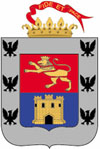 |
Cartago Coat of Arms |
The story takes place in the city of Cartago which was the first capital of Costa Rica. Cartago was the oldest Spanish settlement in the country dating back to 1563. It was made a city by the Spanish crown in 1565. The capital was moved to San José, about 25 kilometers away, in 1823 shortly after Costa Rica, and most of the other latin american countries, declared independence from Spain (see CR History Part II).
Cartago was always very conservative and strongly empathetic towards the Spanish Crown. As late as 1814, only seven years before independence from Spain, the Cortes or Parliament in Madrid gave Cartago the title of "Muy Noble y Muy Leal" (Very Noble and Very Loyal). That would soon change, but the people of Cartago remained very conservative nonetheless.
 |
La Segua - Too Much Guaro Amigo? |
The legend recounts that in Cartago there lived a very beautiful Cartaginesa (female inhabitant of Cartago) who fell in love with a Spanish captain. This lady had incredibly smooth, white skin and long flowing black hair, truly a beauty.
A certain Spaniard, a drunk, tricked her. He made improper sexual advances towards her and being the good Christian and Catholic girl that she was, she rebuffed him (actually the legend is not really clear on that point). The captain then disappeared from the scene and the girl went insane and turned into a monster (La Segua) with the head of a horse (GG had a girlfriend in high school who acted this way).
After that, when any drunk was riding along the road at night in or near Cartago they would encounter a beautiful woman by the side of the road. Thinking the damsel was in distress, the rider would offer to have her ride at his back sharing the saddle, but looking back at her later, he would see the monster with the head of a horse and fiery red eyes, La Segua, and be terrified. The moral? I'm not sure, but it's either "Don't pick up strange ladies", or "Don't drink too much guaro" or both.
So if you find yourself riding around Cartago at night, watch out for the beautiful damsels on the side of the road..
¡Pura Vida!
Life's a Beach
(How Negatives Can Be Positive)
Having grown up on and frequented ocean beaches for some 70 years now I've always thought of a beach as being therapeutic because I've always felt better on a beach sniffing salt air and enjoying the sun and salt water. Evidently, the beach as therapy is now no longer a strange concept to some medical scientists as well. They believe they know the reason why most people feel better at the beach than in an office or at home..
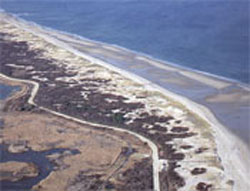 |
Plum Island, MA |
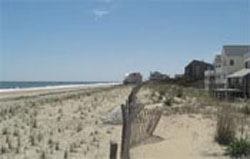 |
Rehoboth, DE |
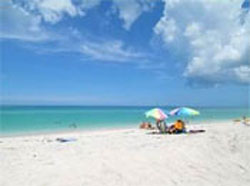 |
Siesta Key Beach, FL |
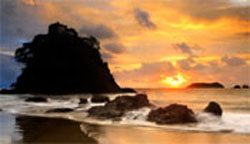 |
Manuel Antonio Beach at Sunset |
First, my personal story. There have been four beaches very significant to GG's life.
The Golden Dude spent his first 20 years growing up on a beach in Massachusetts, a place called Plum Island, about 35 miles north of Boston. Plum Island is a strip of land some nine miles long and a half mile deep at its widest point. The western side of the island is a salt water marsh that attracts wildlife like Canadian geese. As a boy and young man I awoke many times in the fall to the dull thud of hunter's guns exploding in the distance. The marsh also provides breeding grounds for many types of fish. Along the eastern side of the island is the Atlantic. Only three miles of Plum Island's nine mile length are inhabited; the rest is a federal wildlife reservation and bird sanctuary.
It was estimated back then that Plum Island had 600 permanent residents in the winter and about 10,000 visitors, mostly tourists from the greater Boston area, other states and Canada in the summer. In the fall, after Labor Day, the beach was empty and walking along its six miles of uninhabited sand dunes was tantamount to a spiritual experience.
After college, marriage and starting a family, we lived in several inland locations in Ohio, Pennsylvania and Belgium for more than 30 years but even then we usually spent at least two weeks vacation a year for most of those years, on beaches like Rehoboth, Delaware. This is a beautiful Atlantic Coast beach in southern Delaware, much more populated than Plum Island, and also a playground for Washington, D.C., a beach where you'll find a number of other countries summer embassies.
A new and intense chapter of beach devotion and addiction began in 1998 at GG's #3 significant beach experience in Florida. I moved as a single person to Sarasota, Florida and ended up five minutes from the main beach on Siesta Key which is situated on the Gulf of Mexico side of Florida. Siesta Key is one of the most incredible beaches in the U.S. and has routinely been ranked in the top ten around the world as well as being ranked #1 in the U.S. several times. Characteristics of Siesta Key are super fine, white sand (called "sugar sand") and warm turquoise waters with a gentle surf. GG was fortunate to live near this fabulous beach for almost exactly 10 years (September 29, 1998 to September 21, 2008).
Beach #4 is the one I enjoy today, Manuel Antonio. The sand is darker and the surf can be rougher than Siesta Key but the beauty here is also astounding. Mountainous jungle that comes right down to the sea and rock islands large and small dotting the ocean just off the shoreline. It's beauty is in it's wildness. And where else can you get a white faced monkey to come up and steal from your backpack?
In each of these places I was drawn to the beach and always felt better after leaving. So it was with interest that this beachophile read an article on WebMD that claims there actually is a therapeutic value to being at the beach and that they know the cause behind the feeling of well being one gets there. It's all about negative ions, says the WebMD article and this is what they claim:
 |
Dr. GG at the Beach (Aw C'mon, I Did Look Like that Once) |
"Negative ions are odorless, tasteless, and invisible molecules that we inhale in abundance in certain environments. Think mountains, waterfalls, and beaches. Once they reach our bloodstream, negative ions are believed to produce biochemical reactions that increase levels of the mood chemical serotonin, helping to alleviate depression, relieve stress, and boost our daytime energy.
You may have experienced the power of negative ions when you last set foot on the beach or walked beneath a waterfall. While part of the euphoria is simply being around these wondrous settings and away from the normal pressures of home and work, the air circulating in the mountains and the beach is said to contain tens of thousands of negative ions -- Much more than the average home or office building, which contain dozens or hundreds, and many register a flat zero."
Evidently, negative ions are produced in great quantities by waterfalls and crashing waves moving fast through the air . The WebMD assertion compliments a recent Fox Extra television report I saw that said a study has shown that people who live near the ocean live longer.
I guess we'll be hearing more and more about the importance of negative (and positive) ions in our world and our health. If you recall, the Chronicles filed a report last month called All About Lightning that showed how positive ions cause electrical discharges in the atmosphere and how they can be dangerous.
So, if you take advantage of negative ions at the right time, you may extend your life, but don't test that theory in a thunderstorm. In the meantime, just enjoy the beach; life's a beach!
What's-in-a-Word
Segua
It's not certain whether this term came from phonetic pronunciations of mesoamerican Indians or might have been introduced by the Spanish during their colonization of the Americas. It's even possible that the Spanish got it from Italy where there are still family names and even a county named "Segua".
Mesoamerica
Mesoamerica is a region extending from southern Mexico through Belize, Guatemala, El Salvador, Honduras, Nicaragua and northern Costa Rica. With the exception of Panama, this area pretty much encompasses what is today called Central America. Traditions and culture in this region stared as far back as 7,000 years ago and developed separately from other parts of the Americas.
ROMEO Corner
(Retired Old Men Eating Out)
The New El Gran Escape
(Note: This restaurant changed its name to Runaway Grill shortly after we reviewed it as El Gran Escape)
Location: Sunset Place, North End of Marina Pez Vela, Quepos
Hours: 11:30 AM to 10 PM Monday thru Sunday
Parking: Ample aside the restaurant.
Contact: Tel.: 2777 0395; Email: N/A; Website: N/A
Reviewing ROMEOS: Brian K., Todd P., Bob N.
To Review Our Rating System and Procedure, go here: R.O.M.E.O. Rating System
.jpg) |
View from the Dining Room Just After Sunset |
This is a brand new version of an iconic restaurant that had been serving Quepos for decades. The old restaurant was reviewed in March of 2011 and that review can be found here: El Gran Escape Review March 2011.
Also, the pricing is still fair so we didn't change the cost rating either. As a result the Value Index remains at 125, putting it in the top 1/3 of restaurants so far reviewed.
There really is no reason to change the rating this restaurant received in the earlier review, which was five sloths for atmosphere, food quality and service. Although the view has been dramatically improved and includes the new marina, the Pacific Ocean and sunsets, five sloths is our maximum rating and can't be improved upon. The menu, at the time of this writing time is exactly the same as the old restaurant, in fact, they are the same menus and haven't as yet been reprinted. This is an eclectic menu offering a wide variety of appetizers, fish, meats, Latino, American, Mexican and other dishes. All are well prepared and tasty. GG had a lunch and another dinner at the new location before we did the formal review and it was a great experience all three times. |
 |
|---|---|
$ $ $ $ |
|
Value Index = 125 |
Get to the restaurant by 5:15 PM to see a great sunset and view. You can't help but enjoy the overall dining experience.
We wish the El Gran Escape long life in their new location.
don Beto de Quepos,
El Gringo Dorado Pura Vida! |
Be pithy but kind. I'm sensitive. |
|---|

